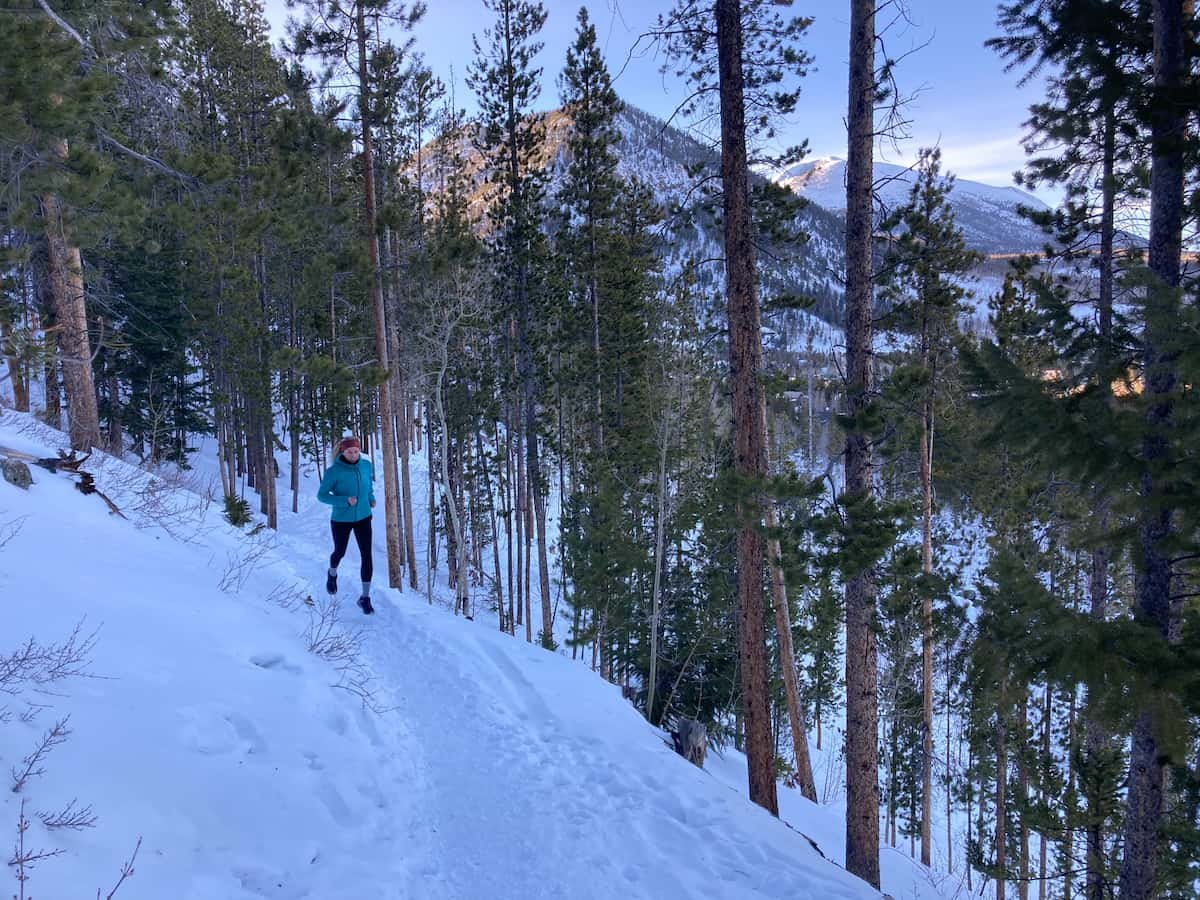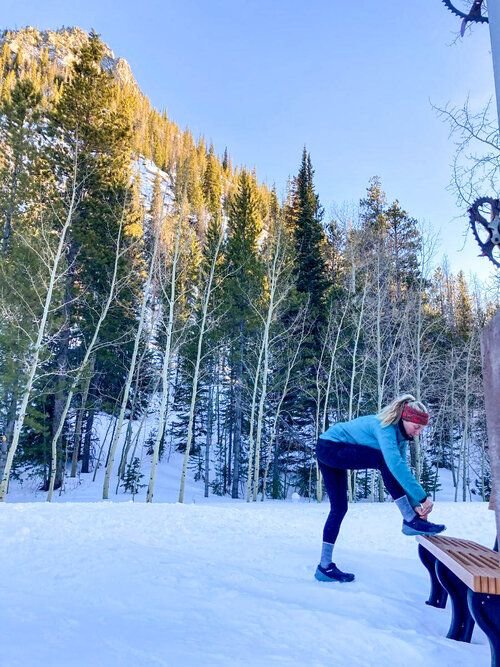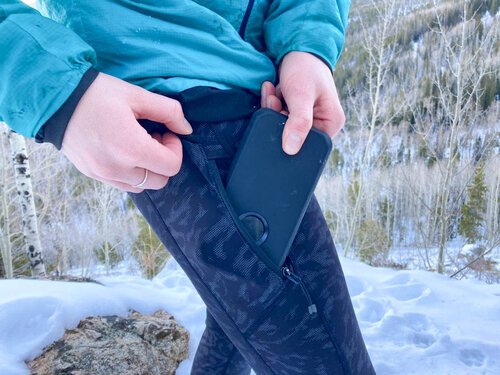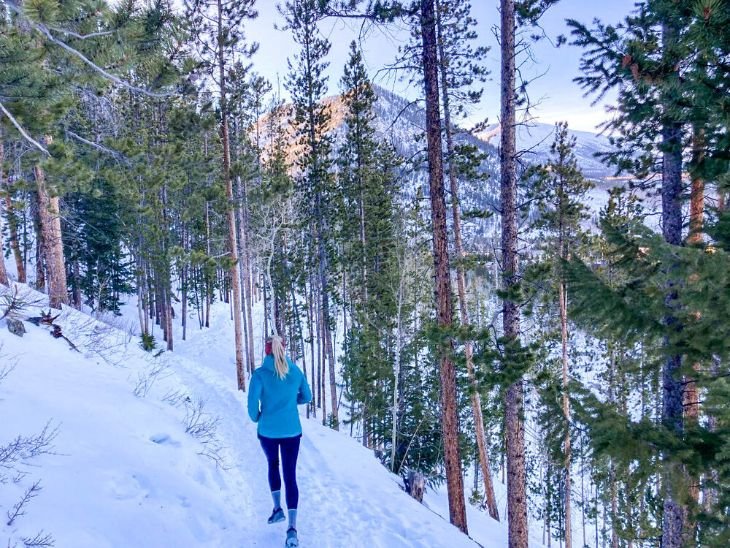How to Run in Winter — 13 Tips for Running in the Cold
Winter running advice, hydration, and what to wear when running in winter
November 7th, 2024
Running when the temperatures are warm and the sun is shining is an activity many people favor; running through the windy, dark winter months is a different beast. That doesn’t mean it can't be just as enjoyable and rewarding as running on the longer, warmer days of the year – with the right gear, skills, and preparation.
If you’d prefer to avoid the treadmill like many of us outdoor runners, there are ways to keep safely running outside all year. With a few tweaks to your routine and the right gear, you’ll be set to log miles right through the winter solstice and beyond.
I'm a trail runner who lives in the high country of Colorado and runs year-round. These cold weather running tips and gear list will help you maintain your body temperature and motivation.
We create reader-supported, objective, independently-selected gear reviews. This story may contain affiliate links, which help fund our website. When you click on the links to purchase gear, we may get a commission — without costing you an extra cent. Thank you for supporting our work and mission of outdoor coverage for every body! Learn more.
13 tips for Running in the Cold
1. Stay warm and know your threshold for cold
Winter running can be as rewarding as in the summer. Photo courtesy Stasia Stockwell.
Be sure to dress for cold weather conditions and pay attention to the temperatures and wind chill to avoid frostbite and hypothermia. Every runner is different in terms of how much cold they can handle.
Ease your way into running in cold weather: Start on milder days and slowly increase the time you spend out there to adjust and dial in how you layer your clothing. Recognize your limits; know when it’s too cold for you to maintain your body temperature to stay running outside. On those days, opt for the gym instead. Once you’re running, recognize when to turn around. Be prepared to stop if the weather shifts or your body shows signs of frostbite or hypothermia.
2. Check the weather forecast before you go
Sunny days that linger in the 30-degree range can be perfect for running in; contrarily, days when the temps hit single digits or dip into the negatives with a brutal windchill could be signs to stay inside for the day.
Wind, especially in winter, should not be underestimated. Not only can the cold wind do a number on its own, but it can also cause evaporative cooling when you’re sweating – a good thing in the hot summer months but something that can lead to hypothermia rather quickly in winter.
Snow and winter conditions shouldn’t stop you from getting out. But, if the forecast calls for blizzard conditions or visibility is significantly impacted, wait for the weather to settle before going out. Especially if you're a road runner, stay aware of snowplows and always wear reflective clothing so you’re easily seen.
For trail runners, take note of your route and ensure it does not pass through avalanche terrain. Staying below treeline and away from slopes steeper than 30 degrees is a safer bet. Check local avalanche conditions before going for a winter run in the mountains. You can check this on sites like the Colorado Avalanche Information Center and the Utah Avalanche Center. In some years (especially in Colorado), like 2019 and 2021, winter running routes that have been popular in previous years have proven to be dangerous.
3. Know your route and have a map (or mapping app) to navigate back home
A hydration tube, headlamp, and navigation tools like a GPS watch can be essential to staying safe while winter backcountry running. Photo courtesy Stasia Stockwell.
Like any trip outdoors, when on winter trail runs, tell others where you are going and when you expect to be back. Get a mapping app for your phone and preload maps on your GPS watch before your run. Our guide to Best GPS watches recommends watches with full-color maps and long battery lives, especially for running in cold weather where battery life can be impacted.
Backcountry runners should strongly consider carrying an emergency beacon like the Garmin inReach Mini 2 in addition to their phone. Winter is a good time to stick with a regular route. Remember, days are shorter, and a headlamp is your friend (see more below). The consequences of getting lost while running are much more severe in the winter than in the summer. See our guide to The Best Personal Locator Beacons for our recommendations on small and lightweight safety devices.
4. Use ice traction devices when necessary
Winter running for many also means ice and snow on the road or trail. Make sure your trail running shoes have a good grip on the ice, mud, or other wet slippery rocks, roots, or sidewalks that are common in winter.
To avoid slipping during your run, survey your regular running haunts for the trails and pathways that melt out the quickest. However, avoid trails that get a daily melt and refreeze cycle, as these can be slick. In particular, early pre-dawn and morning runs on southeast to southwest facing aspects can be slippery because these roads/trails are likely to melt during the day and refreeze at night. See our Best Winter Traction guide for suggestions. In more temperate areas, winter means cold rain. Seek out the routes that let you avoid the mud.
While it requires a little more preparation and attention to the weather, if you plan and prepare for winter conditions, you’ll be able to get outside to run all year long.
5. Find motivation for winter running
Perhaps the most challenging part of winter running is finding the motivation to lace up your shoes even when the snow flies, the mercury takes a deep dive, and the wind chill value feels soul-crushing. While these certainly are challenges, consider them opportunities to run at a mellow pace, listen to the peaceful quiet of winter, and find the same rewarding benefits of running as during the rest of the year.
Running through the winter also means that, come summer, you don’t have to go through the re-entry phase of getting back in the running groove. You’re already there and ready for more.
Accountability is a great motivator. Some runners prefer solo miles, but for others, finding a running buddy can help you get out the door on those cold and dark winter days. Finding another runner friend to check in with can help you reach your winter running goals, even if you prefer to run alone. Winter trail running is a great time to find a running buddy for safety and camaraderie.
6. Do a pre-run warm-up Indoors
Winter running is a good time to up your warm-up routine. Photo courtesy Stasia Stockwell.
A good warmup routine is essential no matter what time of year you’re running, but it’s crucial in the chilly months of winter. Before you head outside, take a few minutes inside to get your blood moving and build up body heat. Warming up will prep your muscles for the miles ahead and make getting out the door a little easier. And don’t let yourself cool down before heading outside.
Remember, though – your warm-up should be just enough to get your blood flow up and not enough to make you sweat. Sweat and cold weather are not a good combo since cold air wicking moisture from your body (evaporative cooling) can cause you to get chilled quickly. So, it’s best to avoid sweating before you head out for your run.
Take time to do a few jumping jacks, a bit of gentle yoga, or any other mellow activity to activate your body for a few minutes before your run. Warm-up is also a great time to get some last-minute pre-hydration in. Sip a warm cup of water or hydrating hot beverage (like herbal tea or even a warm sports drink) while you warm up, and you’ll feel good and ready to get out and run in colder temperatures.
7. Learn to layer
Unlike the minimal running attire needed for warmer months, finding the winter layering system that works best for you requires a bit more thought. Dialing in your layering system will make winter running much more comfortable and help you stay out in cold temperatures for longer. Finding the proper layers for the right conditions will help you manage sweat while keeping you warm.
While you’re bound to break a sweat at some point, keeping sweat to a minimum will help you stay warm. When winter wind rips through sweat-soaked layers, you’ll realize how quickly it can chill you to the bone. Finding the right layers and managing pace will help to keep this from happening – but know that sometimes it takes a little trial and error to find what layers work best for you. You'll likely do a fair bit of donning and shedding your outer layer and mid-layer to stay comfortable and dry. Avoid cotton in all of your layers — once cotton gets wet, it makes you colder.
Ideally, you’ll want to wear torso layers that can easily be removed or added during your run. Start with a good, wicking base layer shirt that will help insulate you without causing you to sweat too much. We love merino wool layers for cold weather running, but there are many good options to choose from (and you can check out our favorites in our Best Base Layers story).
Depending on how cold it is or how warm you tend to run, you can add a lightly insulating mid-layer on top of this, like a light fleece. Many runners prefer a lightly insulated vest for their mid-layer, as a vest doesn't inhibit your arm swing yet warms your core temperature. If the wind is ripping or there’s precipitation in the forecast, a light wind shell will go a long way to keep you toasty and happy.
Your favorite running shorts will be like an old friend you never see anymore, and a lightly insulated pair of running tights or running pants will become your new best pal. Look for a pair with a combo of lightly brushed fabric for insulation, material that wicks sweat well, and a tight weave that fends off the chill from the wind.
There’s a great deal of power in a good pair of socks regarding winter running. Rather than the low-ankle socks that many runners prefer for warm weather, opt for longer thermal socks to protect your ankles from cold weather. Merino wool socks offer great wicking capabilities and provide excellent warmth, even when wet, to help keep your feet both warm and blister-free.
A pair of waterproof or GORE-TEX running shoes is also an excellent footwear addition to your winter running kit. The waterproofing membrane helps to keep your feet dry and keeps them warmer too. If you don’t have waterproof shoes or frequently will be running in wet and cold weather, also consider waterproof socks (check out our full guide!).
They aren’t common, but brands are increasingly making shoes designed for winter running. See our in-depth review of the La Sportiva Cyklon Cross GTX trail running shoes for more information on a pair of winter-specific shoes.
Related Articles:
8. Stay hydrated for winter runs
Unlike on hot summer runs when you can’t help but guzzle ice-cold water, hydrating for winter runs can be trickier. It is much less appealing to chug ice water when the ambient temperature is well below freezing, but your body also loses more moisture through your breath in winter thanks to increased evaporation in the cold, dry air.
Likewise, your sweat will evaporate quicker, and you may not realize how much water you’re actually losing. These conditions make it all the more important to consciously hydrate on cold winter runs.
Running vests are a great way to carry water on longer runs, and many have the option of carrying either a bladder, bottles, or both. For winter running, we recommend a bladder for when temperatures are above freezing, but stick to bottles when it’s below freezing because they’re much less likely to freeze. In our testing experience, that has worked better for us than trying to insulate the hose on the bladder.
Pre-hydrating is an excellent way to prepare your body for winter runs – and it’s always a good idea at any time of year. Drink a cup of warm water or a warm hydrating beverage like herbal tea or a sports drink before bed and before heading out on your run to ensure you’re not dehydrated before you lace up your running shoes.
9. Go slow and steady
During summer, many runners focus their energy on increasing speed and distance and training hard for races and big running goals.
Use running through the winter as a time to maintain your running base. Whether you’re trail running or road running, snow and ice can slow you down on your regular routes – and that’s okay. A slow and steady pace on winter runs can help you hopscotch your way through the changing conditions of winter terrain, and it gives your body a chance to recover from the more intense, speedy miles that often come with summer running.
10. Stay safe in the dark/low light conditions
In most places, winter goes hand in hand with shorter days, meaning you’re more likely to be out before the sun is up or after it’s set. Carry a headlamp with you during these times, and be sure of your route, especially if you’re running on a trail. And remember the importance of reflective gear, especially if you’re a road runner. Conversely, if you're running on a sunny winter day, consider wearing running sunglasses, as snow reflects UV rays. Check out our winter running gear list (below) for some of our favorite items this time of year.
11. Protect Your Extremities
Don’t forget to protect your extremities on your winter runs. Wear a hat or headband to keep your head and ears warm. Use gloves or mittens to protect your hands. And, finally, consider a neck gaiter or scarf to cover your face if it's very cold.
12. Choose the Right Footwear
Depending on where you live and the conditions you’ll be running in, you may need to change up your footwear. But in general, opt for running shoes with good traction, such as a Vibram sole, to prevent slipping on icy or snowy surfaces. If there is precipitation of any kind — rain, sleet, or snow — you may want to upgrade to waterproof or Gore-Tex running shoes. And if you’ll be running in the snow, consider using gaiters to keep snow out of your shoes. Read more about how to choose trail running shoes, or our men’s and women’s trail running shoe guides.
13. Post-Run Care
As soon as you get home, change out of your wet clothes as soon as possible to prevent getting chilled. As your body cools down post-run, those wet layers will make you feel even colder. If you’re having trouble warming up, try a hot shower or bath.
Don’t forget that recovery is a big part of training. Consider wearing Recovery Shoes, stretch and/or foam roll, and try to get good sleep.
A small running pack or vest can help you comfortably carry the gear you need to be safe in the backcountry. Photo courtesy Stasia Stockwell.
What to wear when running in the Cold
Your gear list for running in summer or during warmer seasons will inevitably differ from what you need for getting out there in the dead of winter. Here’s our list of essential pieces of gear for winter running.
The best winter running tights allow you to have easy access to your phone. Phone batteries can be drained by cold temperatures, so storing it close to your body may help keep it functioning. Photo courtesy Stasia Stockwell.
Insulated running tights or pants
Your favorite shorts won’t cut it this time of year. Find a pair of pants or tights specifically designed for winter running. The fit will be designed for a range of motion when running, and there may be a light fleece lining or another form of light insulation. See our guide to The Best Men's Running Tights and The Best Women’s Winter Running Tights for our recommendations.
Cold weather base layer shirt
A good base layer for winter running should keep you warm but not too hot. Sweat management is essential with winter aerobic activities. A wool blend or hybrid base layer with both merino wool and synthetic fibers is a great option. See our Best Base Layers guide for our recommendations.
Layers are essential to regulating temperature on a winter run. Photo courtesy Stasia Stockwell.
Lightweight, weatherproof jacket
Find a lightweight, windproof, waterproof, or water-resistant jacket that’s easy to stash in your running pack. You may not need it for the whole run, but it's always good to bring it along for winter runs. See our Best Women's Running Jackets or Best Lightweight Rain Jackets guide for our recommendations.
Light hat or headband
Even though you’re out running in cold winter temps, you’re still likely to work up a sweat. A thick beanie is often overkill for winter runs, but you still need something to protect your ears from wind and cold exposure, as ears have thinner skin and are susceptible to frostbite more easily than other body parts. A thin hat, running hat, or headband is ideal for this.
Neck gaiter or neck warmer
A lightweight neck warmer (also called a neck gaiter) is a small, mighty piece of gear for winter runs. It helps keep your neck and face protected from the wind. It can also help fend off frostnip. We prefer merino wool for the best thermoregulation.
Wool socks
A thin synthetic sock may be good in summer, but you’ll want something with a little more insulation for winter. Find a good-fitting wool blend sock for cold weather runs. We recommend a merino running sock for winter. See our Best Running Socks for our recommended colder weather running options. You may also be interested in waterproof socks to keep your feet more dry.
Waterproof running shoes
A waterproof running shoe will not only help keep your feet dry, but it also keeps them warmer. Many winners in our Best Women’s and Men’s Trail Running Shoes guides are available in Gore-Tex or waterproof versions for winter running.
Lightweight running gloves
Another essential piece of winter running gear is a pair of lightweight running gloves. Get a pair with touch-screen compatible fingertips so you can easily change your music, check your GPS app, or make a call if necessary. See our guide to Best Winter Gloves for lightweight gloves that we recommend.
Running packs or running vests have a minimalist profile designed to not impact your running style. Photo courtesy Stasia Stockwell.
Running pack
A good running vest or pack is excellent gear for longer runs in any season, but it’s more beneficial in winter when you’re likely to carry more layers. A good pack should fit well, minimize bounce, and be able to carry water, fuel, and a layer or two. See our Best Running Hydration Vest for our recommendations that are built around bottles instead of hoses. In our experience, hydration hoses can freeze, even with insulation.
Days are shorter in the winter. If you enjoy running before or after work hours, you may find yourself running in the dark. Bring a good headlamp and back-up batteries. Photo courtesy Stasia Stockwell.
HEADLAMP
Not all headlamps are created equal, and if you’re winter running, you need one that is both minimal and comfortable while being bright enough for dark mornings and evenings. We recommend a bright headlamp with a backlight, especially if you are running along roads. See the winners in our Best Running Lights story for more recommendations.
Reflective gear
Don’t forget that you must be visible on your runs, especially in winter. Winter weather can roll in and decrease visibility even if it's not dark. Having reflective gear – whether it’s detailing on your pants and jacket or a full-on reflective vest – is essential. Read our story on Best Reflective Gear for our time-tested favorites.
Sunglasses
It seems counter-intuitive, but if you're running on a sunny winter day, consider wearing running sunglasses, as snow reflects up to 80% of UV rays.
With the right skills and gear, you can enjoy the beauty of nature year-round. Photo courtesy Stasia Stockwell.
Benefits of running in the cold
There are many benefits to running in the cold and outdoors through the winter months. Exercise improves our moods, primarily through the endorphins released during activity. But doing this exercise outside is even better since fresh air and sunshine (even if it’s a cold day and there’s snow on the ground) can work wonders to help fight things like Seasonal Depression Disorder (SAD) that often lingers in the darker, colder months of the year.
On top of that, running in the cold is often easier on the body than running during hot summer days. The cooler temps create less stress on the body than exerting yourself under the hot August sun.
But perhaps one of the simplest benefits of running through the winter is that it makes it easier to keep your running stride going year-round. Instead of taking the winter off and having a rude awakening on that first spring run, the consistency of running through all the seasons builds and maintains a stronger base for runners.
Like road running and trail running in the summer, winter road running and winter trail running require some different gear and skills. Photo courtesy Stasia Stockwell.
Where to run in winter: road running vs. trail running
Where you run in the winter will depend on your location and personal preference. Whether you live near or prefer pavement or wooded mountain trails, you’ll reap the rewards of lacing up through the season.
Remember that road runners will benefit from different gear than trail runners. No matter where you are, layering is essential. But road runners should focus more on reflective gear than trail runners, and trail runners may need more beefy traction and might benefit more from using a pair of running gaiters than road runners.
Trail runners should also be more conscious of avalanches and the consequences of getting lost while running in the winter and will benefit from good mapping tools and a way to communicate with others, including an emergency messenger.
FAQ
What temperature is too cold to run?
There is not necessarily a set threshold that works for all runners across the board regarding temperature. Take time to adapt to running in the cold and learn what’s comfortable for you. If it’s so cold that you’re not enjoying being out there or experiencing signs of frostnip (a precursor to frostbite) or hypothermia, that’s a sign that it’s time to head back inside.
Is running in cold air good for your lungs?
Running in the cold is not necessarily better for your lungs than running in other weather conditions or temperatures. No matter the conditions, aerobic activity is good for strengthening your lungs and cardiovascular system.
Why do lungs hurt after running?
You may notice more coughing and sensations in your lungs when running outside in the cold or during cold-weather exercise. This is due to your lungs reacting to the cold, dry air. It’s not inherently bad, but use caution and note how your body feels, especially if you have a respiratory condition like asthma.
Why is it so hard to run in the cold?
Running in the cold takes getting used to, and it may require more internal motivation to get out there when it’s snowy or during freezing temperatures. But as you get used to it mentally and physically, you’ll reap the rewards of getting outside for exercise in the winter season.
Does running in winter burn more calories?
Winter running can sometimes burn more calories than running in the summer, mainly because it requires a little more energy for your body to stay warm. But this is not always the case and depends on several other personal factors such as your pace, metabolism, and more.
Stasia Stockwell is a 4-season adventurer. Photo courtesy Stasia Stockwell.
Author’s expertise: why you should trust us
A true mountain dweller, Stasia feels far more at home on a high alpine ridge than on a busy city street. She's worked as a backpacking guide in southeast Alaska and has written for outlets like Backpacker, REI Co-op Journal, and The Dyrt, among others.
Stasia is a lifelong skier, mountain biker, and trail runner passionate about lowering barriers to entry for outdoor sports. She hopes to inspire people to love and respect the wild natural world through her work.
Stasia Stockwell has been an avid runner for over a decade. She found her love for the sport in college when she ran primarily on the road. After moving to Breckenridge several years ago, it didn’t take long to realize that trails are where she prefers to pound dirt.
She’s run multiple half marathon road races and an alpine marathon in the San Juan mountains. She now logs mountain miles year-round, even through the chilly, snowy Summit County winters.
You can see all of Stasia's stories at Treeline or at her website.















